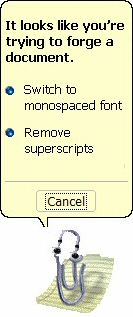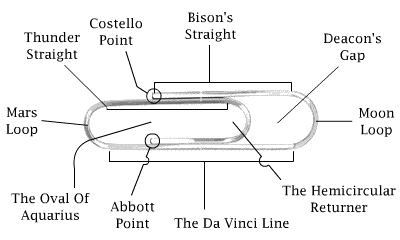Paper clip
The paper clip (or easily removable stainless elastic steel wire based pressure induced friction and torsion binding device) is a mechanism for fastening pieces of paper together without adhesive. It is used mainly by large industry, the only organisations capable of amassing enough money to buy them in bulk. It was invented by King George VI and Elvis Costello.
Technical specifications[edit]
Paper clips vary in size, from infinitesimal to ridiculous. The smallest paper clip in the world could be fit 29,000,000,006 times onto a pin head, whereas the largest is seven times larger than Belgium, and is home to several hundred Inuits in the north of Canada. However, most paper clips are described as "big enough".
They come in many different colors, but mostly silver, as it has been proven by the Professor of Paper Aggregation Technology at Queen's College Oxbridge that silver is the best colour for fastening sheets of paper together. The professor also claims there are reams of paper living wild in the highlands of Scotland, so perhaps this information should not be taken at face value.
Components[edit]
Costello Point[edit]
Named after one of the two inventors of the paper clip, the Costello Point is specially designed to let paper slip into the mechanism. It creates a gap between itself and the Thunder Straight (see below) which allows thin objects (such as paper and, perhaps, wafer-thin ham) to pass between them. Previous designs utilizing the "razor point" instead of the Costello were abandoned due to damage caused to both paper and user.
The cross-section of the Costello Point is often described as circular when, in fact, it is an oval — a mysterious, sometimes referred to as quantum shape — which exists only in paper clips (see also Oval Of Aquarius, below).
Bison's Straight[edit]
Bison's Straight is the feeding mechanism for the paper into the clip. It uses the concepts of Henry L. Bison,[1] an American philosopher who used Newton's gravitational theories to work out that paper will group together only if forced to by an external object.
Deacon's Gap[edit]
Deacon's Gap[2] is one of the two parts of the paper clip designed to let the paper "breathe". Without the Gap, the paper would turn all mouldy, brittle and disgusting.
Moon Loop[edit]
The Moon Loop, directly opposite the Mars Loop (see below), is the longest piece of curved metal on the paper clip. It ensures the rear-side of the paper does not slide backwards, dislodging it from the mechanism and causing a Total Paper Catastrophe (TPC).[3]
Da Vinci Line[edit]
The Da Vinci Line is the longest piece of metal on the paper clip. It is based on a sketch by Leonardo Da Vinci,[4] where he determines the exact dimensions of a rudimentary paper clip, several hundred years before the modern invention.
Mars Loop[edit]
The Mars Loop is the only part of the paper clip that is visible both from the front and from the back when fastening paper together. As such, it is the most important part of the mechanism, and also the part the most prone to failure. Early paper clip models were notorious for Mars Loop Failures (MLFs), so much so that Microsoft attempted to reinforce theirs with spare pieces of computer hardware. It was due to this that Mr. Clippy was born (but see below for the problems this created).
Thunder Straight[edit]
The Thunder Straight works in conjunction with the Abbott Point and the Bison Straight to ensure the paper stays in place.
The Thunder Straight is so called because, in earlier models, the mechanism was known to let out large static shocks to anyone who touched it. It was believed that friction between the paper and metal was to blame, but instead it was noted that the largest paper clip factory in the world was situated right next to the first-ever static electricity power station.[5]
Hemicircular Returner[edit]
This extremely important part of the clip allows the Abbott Point to be connected to the Mars Loop and Thunder Straight without an unnecessary zig-zag across the Oval of Aquarius. Without the returner the cost of making paper clips would bankrupt the entire world within a couple weeks. They would also look ugly.
Abbott Point[edit]
Named after the second of the two inventors of the paper clip, the Abbott Point is in fact a rather useless part of the clip. It is there only because something needs to hold the paper against the Da Vinci Line. Then again, if there were no Abbott point the clip would continue past where the point currently is, spiralling further and further inside the Oval of Aquarius until critical mass is achieved and a black hole is created.[6]
Oval Of Aquarius[edit]
Like Deacon's Gap, the Oval of Aquarius is a gap used to let the paper breathe. However, it also utilises the quantum oval idealology, and therefore has much mythology attached to it. A Church of the Latter Day Paper Clippers has started up in the Deep South of America, while pagans around Stonehenge in the UK believe the universe is one giant paper clip, and that the Earth is only part way along the Galactic Bison's Straight.
Strangely, the ancient Sanskrit symbol for "Obey Oprah" rather resembles a paper clip.
Theory[edit]
Clip Theory[7] is the study of all matter in the Universe in its relationship to paper clips, commonly studied in college between Scissors 102 and Stapler 205. Clip Theory has also challenged modern scientists, creating disputes among businessman and physicists.
Usage[edit]
A survey by the International Organisation Of Paper And Cardboard Collection, Fastening And Recycling (IOPCCFR, pronounced "Horace") has revealed that only 1.4% of paper clips are used for fastening paper. The biggest single use is for cleaning fingernails (19.4%).
- fixing broken circuit boards (15.6%)
- creating rubber band catapults (11.9%)
- removing nasal mucus (8.0%)
- poking the eyes of co-workers (7.2%)
- creating scale-models of the Eiffel Tower (6.8%)
- miniature lightning conductors (5.9%)
- torture for beginners (4.3%)
- Christmas presents (4.1%)
- dentistry (3.9%)
- rubbing together to create fire (3.4%)
- headache cure (2.1%)
- tiddlywinks (2.0%)
- poetic inspiration (-1.0%)
- crude calulation for when a calculator is not at hand (0.6%)
- attempting to take over the world in your own specially-designed paper-clip-powered mecha-robot (0.1%)
- TV antenna (0.01%)
It might surprise you to learn that this list covers only 85.8% of paper clips. (If this has already occurred to you, you have way too much time on your hands and need to go outside. Now.)
A paper clip in a pocket, properly maneuvered, can hold your hostage when an actual weapon is unavailable (e.g. at school).
Controversy[edit]
Fakes[edit]
Facsimile paper clips have extended circles instead of ovals. The original manufacturer of paper clips — Papernicht GmbH, coincidentally having trademarked MacDowell's Golden Arcs — settled dozens of lawsuits for an undisclosed sum, believed to be one voucher each for $5 off a clock radio at Wal-Mart.
Mr. Clippy[edit]
Papernicht also sued Microsoft over their office assistant — not because they believed they owned the copyright, but because they found it so bloody annoying.[8] The case is ongoing.[9]
See also[edit]
- ↑ Bison died relatively soon after attempting to get one hundred pieces of cardboard into an experimental (Einsteinian) clip.
- ↑ Named after the 10th Deacon of Scunthorpe, who suffered a fate similar to Bison's.
- ↑ TPCs are the third-highest cause of death in the global workplace, after Stapler Malfunction and Coffee Spillage.
- ↑ Da Vinci's concept had a flamethrower attachment and a gauge for measuring the density of apples in a barrel.
- ↑ An experimental government initiative once required people in nylon suits to walk over shag carpets and touch Van de Graaff generators).
- ↑ So says the Professor of Paper Aggregation Technology at Queen's College, Oxbridge, whom other scientists say is two sandwiches short of a picnic.
- ↑ The first theorem states that any two sheets of paper can be held together with a single clip. (Corollary: it is unnecessary to apply more than one.)
- ↑ It looks like you need help with a suicide note.
- ↑ Word.


